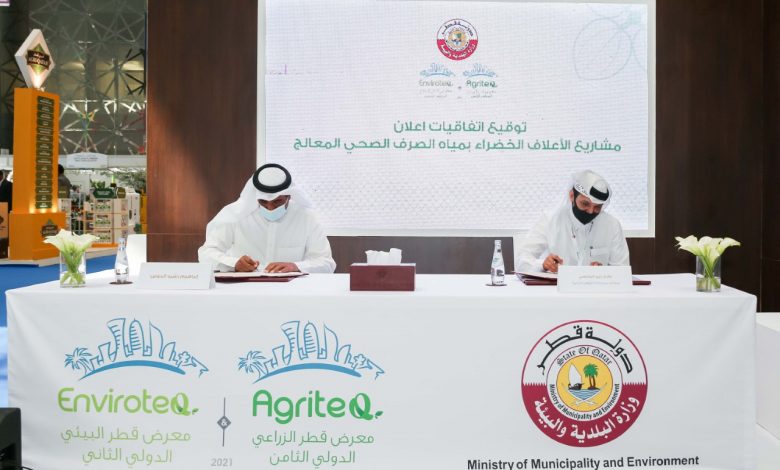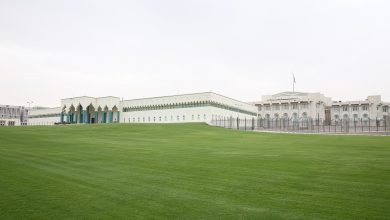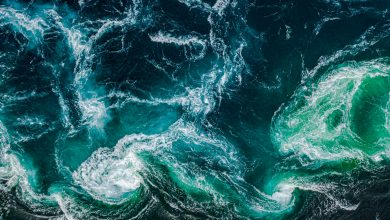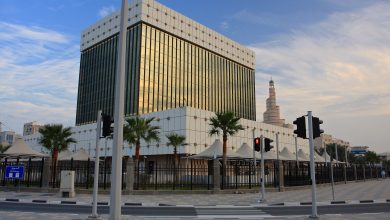
MME Signs Agreements, Contracts to Enhance Food Security
الوزارة توقع عددا من العقود والاتفاقيات لتعزيز الأمن الغذائي
QNA
Doha: The Ministry of Municipality and Environment (MME) has signed a number of contracts and agreements with some concerned authorities in the country to enhance food security and achieve self-sufficiency in strategic commodities. The signing took place on the sidelines of the ongoing 8th Qatar International Agricultural Exhibition and the 2nd Qatar International Environmental Exhibition at the Doha Exhibition and Conference Center.
The Ministry signed a memorandum of understanding with Qatar Development Bank (QDB) to launch an initiative to encourage the production of tilapia, by giving farmers an opportunity to establish productive projects within farms registered in the country, and with concessional financing from Qatar Development Bank.
The initiative includes establishing two projects for the production of tilapia fish with a production capacity of about 310 tons per project per year, with a total production of about 610 tons per year, which contributes to achieving about 70 percent of the country’s self-sufficiency of this type of fish, as these two projects are subject to full technical support from the specialists at the Ministry of Municipality and Environment.
The two projects will give farmers an opportunity to improve their production by taking advantage of the integrated farming system between plants and fish together, relying on fish residues to feed the plants to obtain healthy vegetables that are free of chemicals.
In a statement on this occasion, Director of the Fish Resources Department of the MME Abdulaziz Al Duhaimi affirmed the Ministry’s keenness to adopt projects that support the programs of the National Strategy for the Development of the Fisheries and Aquaculture Sector, and enhance the food security of these products, pointing out that the tilapia fish farming projects will directly contribute to developing and supporting food security and increasing local production of these economically viable species.
For his part, Executive Director of Business Finance at QDB Khalid bin Abdullah Al Mana said that this initiative is the result of joint efforts between the Ministry of Municipality and Environment and the QDB to rely on national energies in the production of this strategic food commodity to achieve self-sufficiency and reduce dependence on imports, pointing out that the QDB seeks, in accordance with its ambitious strategy, to achieve a high rate of self-sufficiency in various productive sectors. The QDB is in close contact with all ministries and competent authorities in the country to find appropriate and effective mechanisms to develop all productive sectors in the country, especially projects related to food security, he added.
Al Mana stressed that this initiative is the best evidence of the QDB’s continuing journey of developing all economic sectors in Qatar, and actively contributing to sustainable development in line with Qatar National Vision 2030, pointing out that launching the production of tilapia fish in Qatari farms is within many initiatives and programs launched in this context, which aims to develop the private sector, especially the agricultural and fisheries sector.
The MME, represented by the agricultural sector, also signed an agreement on contracts for 9 projects for breeding and fattening local sheep and goats, with nine private companies in five complexes: Al Wakra, Abu Nakhla, Al Kharib, Al Khor, and Simaisma, at the rate of two projects in each complex, where each project is on an area of 50,000 square meters.
The initiative to establish sheep breeding and fattening projects aims to achieve the highest possible rates of production according to the highest international standards and to use the best scientific methods in raising local sheep and goats, as well as the ability to collect male sheep from producing farms in the country and fatten them with a focus on the distinct types of them.
The projects will use the best environmental technology and methods to achieve the maximum possible efficiency in the use of resources, while ensuring environmental sustainability.
Each project includes establishing the pens necessary for breeding, the pens needed for fattening, a slaughterhouse, a unit for fermentation of manure, in addition to stores for the production requirements of fodders and others.
The initiative of fattening projects will achieve a set of goals, the most important of which are: increasing the self-sufficiency rate of red meat, making use of farms and traditional farms as a strategic stock for animals producing red meat, creating a permanent outlet for sheep and goat breeders to sell their production for fattening projects, as well as technical and advisory support for breeders.
Director of the Animal Resources Department of the MME Abdulaziz Al Ziyara explained that the MME continues to work towards achieving its goals and implementing its plans for increasing local production of red meat, stressing that offering these projects to the private sector will contribute to achieving food security and increasing the self-sufficiency of this material.
The Ministry of Municipality and Environment, represented by the agricultural sector, signed an agreement to implement contracts for three agricultural projects to produce green fodder using treated wastewater, with three private companies to produce about 10 thousand tons per year, at a production rate of up to 20 tons per year per hectare each.
Plots of land for these projects have been allocated in three areas: Al-Karaana, with a total area of about 1.5 million square meters, and Bu Glaila, with an area of about two million square meters, and Aba Al Hiran, with an area of about three million square meters. Projects to produce green fodder using treated wastewater are one of the important and vital projects that support food security due to the increased demand for it.
Assistant Director of the Agricultural Affairs Department of the MME Adel Al Keldi Al Yafei said that projects to produce green fodder using treated wastewater aim to cover the needs of the local market, noting their role in preserving groundwater by reducing dependence on groundwater and moving to use treated wastewater.
The local market’s annual consumption of green fodder is about 215 thousand tons, while the total production is 115 thousand tons annually, with a self-sufficiency rate of 54 percent. These strategic projects are expected to cover about 10 percent of the domestic consumption gap, as the green fodder production in the State of Qatar will reach about 125,300 tons per year.
Meanwhile, the Ministry of Municipality and Environment and the Qatar Livestock Society (Anaam) signed a memorandum of understanding to launch an initiative to rehabilitate and afforest the mobile farms in the country, with the aim of contributing to preserving the environment and intensifying the vegetation cover with wild tree species from the Qatari environment.
Under the initiative, the Qatar Livestock Society plays an awareness and advisory role to educate livestock breeders on the importance of developing nurseries through afforestation and planting wild plants, and the Ministry of Municipality and Environment, on its part, will provide appropriate wild trees and seedlings and provide technical and advisory support on methods of cultivation and plant care.
HE Assistant Deputy Minister for Agriculture and Fisheries Sheikh Dr. Faleh bin Nasser Al-Thani stated that the initiative, which was launched in cooperation with the Anaam, aims to support the Ministry’s efforts in promoting environmental sustainability by increasing the green area and developing nurseries, explaining that the MME seeks, through the signing of the memorandum, to support all initiatives and activities aimed at increasing afforestation, developing vegetation cover and preserving the environment, while stressing the importance of working in partnership with other bodies and associations to develop nurseries and spread awareness among all segments of society.
Assistant Undersecretary for Environmental Affairs, Eng. Hassan Jumaa Al Muhannadi said that launching this initiative contributes to preserving the environment, mitigating global warming and the effects of pollution, combating desertification and limiting grazing degradation by promoting an increase in vegetation cover and an increase in biodiversity that protects wildlife.
For his part, Anaam President Mubarak Rashid Al Sahouti noted the role of the Society and livestock breeders in preserving the environment, activating the introduction of environmental awareness into the Anaam’s activities, stressing the importance of the initiative in supporting and developing nurseries in the areas surrounding the farms, which will have a positive impact on promoting environmental sustainability and increasing green spaces in the country, while noting the importance of cooperation with the Ministry of Municipality and Environment in such initiatives to achieve the desired goals.
قنا
الدوحة: وقعت وزارة البلدية والبيئة عددا من العقود والاتفاقيات المتعلقة بتعزيز الأمن الغذائي وتحقيق الاكتفاء الذاتي من السلع الاستراتيجية مع بعض الجهات المعنية بالدولة، على هامش فعاليات معرض قطر الزراعي الدولي الثامن، ومعرض قطر البيئي الدولي الثاني المقام حاليا بمركز الدوحة للمعارض والمؤتمرات.
فقد وقعت الوزارة مذكرة تفاهم مع بنك قطر للتنمية لإطلاق مبادرة لتشجيع إنتاج أسماك البلطي، بإتاحة الفرصة أمام أصحاب المزارع لإقامة مشاريع إنتاجية داخل المزارع المسجلة بالدولة، وبتمويل ميسر من بنك قطر للتنمية.
وتتضمن المبادرة إقامة مشروعين لإنتاج أسماك البلطي بطاقة إنتاجية تقدر بحوالي 310 أطنان للمشروع الواحد سنويا، وبإجمالي إنتاج يقدر بحوالي 610 أطنان سنويا، ما يسهم في تحقيق اكتفاء ذاتي بالدولة من هذا النوع من الأسماك بنسبة تقدر بحوالي 70 بالمئة حيث يخضع هذان المشروعان للدعم الفني الكامل من قبل المختصين بوزارة البلدية والبيئة.
وسيمنح المشروعان فرصة لأصحاب المزارع لتحسين إنتاجهم عبر الاستفادة من نظام الزراعة التكاملية بين النبات والأسماك معا، معتمدين على مخلفات الأسماك في تغذية النباتات للحصول على خضراوات صحية وخالية من الكيماويات.
وأكد السيد عبد العزيز الدهيمي، مدير إدارة الثروة السمكية بوزارة البلدية والبيئة، في تصريح بهذه المناسبة، حرص الوزارة على تبني مشاريع تدعم برامج الاستراتيجية الوطنية لتنمية وتطوير قطاع الثروة السمكية والاستزراع السمكي، وتعزيز الأمن الغذائي من هذه المنتجات، لافتا إلى أن مشاريع استزراع أسماك البلطي ستساهم بشكل مباشر في تنمية ودعم الأمن الغذائي وزيادة الإنتاج المحلي من هذه الأنواع ذات الجدوى الاقتصادية.
من جهته، قال السيد خالد بن عبد الله المانع، المدير التنفيذي لتمويل الأعمال في بنك قطر للتنمية، إن هذه المبادرة تأتي ثمرة للجهود المشتركة بين وزارة البلدية والبيئة والبنك من أجل الاعتماد على الطاقات الوطنية في إنتاج هذه السلعة الغذائية الاستراتيجية لتحقيق الاكتفاء الذاتي منها والحد من الاعتماد على الواردات، مشيرا إلى أن بنك قطر للتنمية يسعى، وفقا لاستراتيجيته الطموحة، إلى تحقيق نسبة عالية من الاكتفاء الذاتي في مختلف القطاعات الإنتاجية، وموضحا أن البنك على تواصل وثيق مع كل الوزارات والجهات المختصة بالدولة لإيجاد الآليات المناسبة والفعالة لتطوير كل القطاعات الإنتاجية بالدولة خاصة المشاريع المتعلقة بالأمن الغذائي.
وأكد المانع أن هذه المبادرة خير دليل على استمرار البنك في رحلة تنمية وتطوير كل القطاعات الاقتصادية في قطر، والمساهمة بفاعلية في التنمية المستدامة تماشيا مع رؤية قطر الوطنية 2030، مبينا أن إطلاق إنتاج أسماك البلطي في المزارع القطرية، تأتي ضمن العديد من المبادرات والبرامج التي أطلقها البنك في هذا الإطار، والتي ترمي إلى تطوير القطاع الخاص، لا سيما القطاع الزراعي والسمكي.
كما وقعت وزارة البلدية والبيئة، ممثلة بالقطاع الزراعي، إعلان اتفاق بشأن عقود عدد (9) مشاريع لتربية وتسمين الأغنام والماعز المحلية، مع تسع شركات خاصة في خمس مجمعات هي: الوكرة وأبونخلة والخريب والخور وسميسمة، وذلك بمعدل مشروعين في كل مجمع، حيث يقع كل مشروع على مساحة 50 ألف متر مربع.
وتستهدف مبادرة إنشاء مشاريع تربية وتسمين الأغنام، تحقيق أعلى معدلات ممكنة للإنتاج وفق أعلى المعايير العالمية واستخدام أفضل الطرق العلمية في تربية الأغنام والماعز المحلية، فضلا عن القدرة على تجميع ذكور الأغنام من العزب والمزارع المنتجة في الدولة وتسمينها مع التركيز على الأنواع المتميزة منها.
وستعتمد المشروعات استخدام أفضل وسائل التكنولوجيا والأساليب البيئية لتحقيق أقصى قدر ممكن من الكفاءة في استخدام الموارد، مع ضمان الاستدامة البيئية.
ويتضمن كل مشروع إقامة الحظائر اللازمة للتربية، والحظائر اللازمة للتسمين، ومقصب، ووحدة لتخمير الروث بالإضافة إلى مخازن لمستلزمات الإنتاج من أعلاف وغيرها.
وستحقق مبادرة مشاريع التسمين مجموعة من الأهداف أهمها: زيادة نسبة الاكتفاء الذاتي من اللحوم الحمراء، والاستفادة من العزب والمزارع التقليدية كمخزون استراتيجي للحيوانات المنتجة للحوم الحمراء، وإيجاد منفذ بيع دائم لمربي الأغنام والماعز لبيع إنتاجهم لمشاريع التسمين، فضلا عن الدعم الفني والإرشادي للمربين.
وأوضح السيد عبد العزيز الزيارة، مدير إدارة الثروة الحيوانية بوزارة البلدية والبيئة، أن الوزارة تواصل العمل نحو تحقيق أهدافها وتنفيذ خططها التي حددتها في مجال زيادة الإنتاج المحلي من اللحوم الحمراء، مؤكدا أن طرح هذه المشاريع على القطاع الخاص سوف يساهم في تحقيق الأمن الغذائي وزيادة نسب الاكتفاء الذاتي من هذه المادة.
وفي الإطار ذاته، وقعت وزارة البلدية والبيئة، ممثلة بالقطاع الزراعي، إعلان اتفاق بشأن عقود تنفيذ ثلاثة مشاريع زراعية لإنتاج الأعلاف الخضراء باستخدام مياه الصرف الصحي المعالجة، مع ثلاث شركات خاصة وذلك لإنتاج حوالي 10 ألاف طن سنويا، وبمعدل إنتاج يصل إلى 20 طنا سنويا للهكتار الواحد.
وقد تم تخصيص أراضي هذه المشاريع في ثلاث مناطق هي: /الكرعانة/ بمساحة إجمالية تبلغ حوالي 1.5 مليون متر مربع، و/بواقليلة/ بمساحة حوالي مليوني متر مربع، ومنطقة /أبا الحيران/ بمساحة حوالي ثلاثة ملايين متر مربع، حيث تعتبر مشروعات إنتاج الأعلاف الخضراء بمياه الصرف الصحي المعالجة، من المشروعات الهامة والحيوية الداعمة للأمن الغذائي لزيادة الطلب عليها.
وأشار السيد عادل الكلدي اليافعي، مساعد مدير إدارة الشؤون الزراعية بوزارة البلدية والبيئة، إلى إن مشاريع زراعة الأعلاف الخضراء عبر استخدام المياه المعالجة، تستهدف تغطية احتياجات السوق المحلية منها، فضلا عن دورها في الحفاظ على المياه الجوفية عبر تقليل الاعتماد على المياه الجوفية والانتقال الى استخدام مياه الصرف الصحي المعالجة.
ويبلغ الاستهلاك السنوي للسوق المحلي من الأعلاف الخضراء حوالي 215 ألف طن، فيما يبلغ إجمالي الإنتاج 115 ألف طن سنويا، بنسبة اكتفاء ذاتي 54 بالمئة، ويتوقع أن تغطي هذه المشاريع الاستراتيجية حوالي 10 بالمئة من فجوة الاستهلاك المحلي، حيث سيصل إنتاج الأعلاف الخضراء بدولة قطر إلى حوالي (125,300) ألف طن في السنة.
من جهة أخرى، وقعت وزارة البلدية والبيئة والجمعية القطرية للثروة الحيوانية /أنعام/، مذكرة تفاهم لإطلاق مبادرة “ومن أحياها” لتأهيل وتشجير مجمعات العزب والعزب الجوالة في الدولة، بهدف المساهمة في الحفاظ على البيئة وتكثيف الغطاء النباتي بأنواع الأشجار البرية من البيئة القطرية.
ووفقا للمبادرة تقوم الجمعية القطرية للثروة الحيوانية بالدور التوعوي والإرشادي بين مربي الثروة الحيوانية بأهمية تطوير الروض من خلال التشجير وزراعة النباتات البرية، كما ستقوم وزارة البلدية والبيئة من جانبها، بتوفير الأشجار والشتلات البرية المناسبة وتقديم الدعم الفني والإرشادي حول طرق الزراعة ورعاية النباتات.
وبهذه المناسبة، بين سعادة الشيخ الدكتور فالح بن ناصر آل ثاني وكيل الوزارة المساعد لشؤون الزراعة والثروة السمكية بوزارة البلدية والبيئة، أن مبادرة “ومن أحياها” التي أطلقت بالتعاون مع جمعية /أنعام/، تهدف إلى دعم جهود الوزارة في تعزيز الاستدامة البيئية من خلال زيادة الرقعة الخضراء وتطوير الروض، موضحا أن الوزارة تسعى من خلال توقيع المذكرة إلى دعم كافة المبادرات والأنشطة الهادفة إلى زيادة التشجير وتنمية الغطاء النباتي والمحافظة على البيئة، مؤكدا أهمية العمل بالشراكة مع الجهات والجمعيات الأخرى لتطوير الروض ونشر الوعي بين جميع فئات المجتمع.
بدوره، قال المهندس حسن جمعة بوجمهور المهندي، وكيل الوزارة المساعد لشؤون البيئة بوزارة البلدية والبيئة، إن إطلاق هذه المبادرة يسهم في المحافظة على البيئة والتخفيف من الاحتباس الحراري وآثار التلوث ومكافحة التصحر والحد من تدهور المراعي من خلال تعزيز زيادة الغطاء النباتي وزياده التنوع الإحيائي الذي يحمي الحياة الفطرية.
من جانبه، لفت السيد مبارك راشد السحوتي، رئيس الجمعية القطرية للثروة الحيوانية /أنعام/، إلى دور الجمعية ومربي الثروة الحيوانية في الحفاظ على البيئة، وتفعيل إدخال الوعي البيئي في أنشطة الجمعية، مؤكدا على أهمية مبادرة “ومن أحياها” في دعم وتطوير الروض في المناطق المحيطة بالعزب، والتي سيكون لها أثر إيجابي في تعزيز الاستدامة البيئية وزيادة المساحات الخضراء بالدولة، ومنوها بأهمية التعاون مع وزارة البلدية والبيئة في مثل هذه المبادرات لتحقيق الأهداف المنشودة منها.
جدير بالذكر إن الجمعية القطرية للثروة الحيوانية هي جمعية ثقافية قطرية، تهدف إلى المساهمة في رفع الإنتاج والجودة بالتعاون مع مربي الثروة الحيوانية، من خلال توحيد جهودهم وتقديم المعرفة والخبرات لهم وتذليل أي صعوبات يواجهونها، وذلك بالتنسيق والتعاون مع الجهات المعنية بالدولة.


